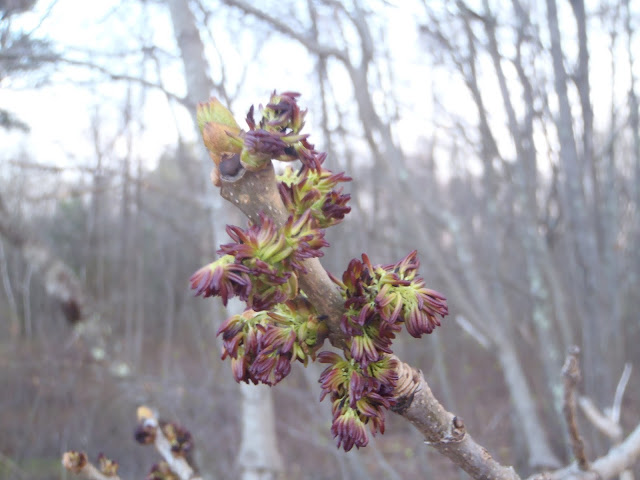I became acquainted with my first ash tree--a white ash--as a new homeowner nineteen years ago. The home inventory by a proud, new member of the landed class who was trained in botany would naturally include plants, and I not only mapped out the various grasses and sedges that clothed the backyard, but also noted the larger trees there and in the little patch of scrubby woodland behind it. The tall, willowy white ash stands at the border between yard and wood.
For years, this was a nodding acquaintanceship. I would sometimes remember to look her way in passing, paying special attention whenever a stiff, gusty wind encouraged her to sway majestically. But for years I didn't even know ashes had gender, much less that this ash was female.
Fall colors; our tree glowing in late afternoon sun.
The relationship became a little more serious a few years ago when I decided to make my dog-walks around the neighborhood into natural history walks as well. I found white ash to be fairly common in the neighborhood. I watched their leaves bronze in the fall, and waited to see them flower in spring. In fall three years ago I worried as the tree dropped much of her foliage prematurely in our local drought, looking terrible by the time the drought ended. That first year I trained binoculars on the high limbs of my tree as it took its own sweet time leafing out, but never saw a single flower.
Soon after, I became aware of the imminent arrival of the Emerald Ash Borer, against which American ash trees have no resistance. This alien invasive beetle first appeared near Detroit in 2002--probably accidentally introduced from Asia in packing materials. It has since spread to about half the area of the US, reaching within a dozen or so miles of Brockton, MA as of two years ago. The boring of the beetle larvae beneath the bark effectively girdles the trees, and kills them. Several species of ash are probably doomed nationwide. (The regular treatments with various insecticides that can save individual trees would be too expensive and labor-intensive to save wild populations.) Volunteers are monitoring for its arrival--an effort I helped with two summers ago as a "wasp watcher."
All this time I had been taming my impulse to learn mainly by reading or Googling; I observed first. But I knew very little about what I should look for, and when. So when the first spring's observations were fruitless, I did a little research. Ash is dioecious, having male and female flowers on separate trees. Male flowers have a profusion of purple stamens, while female flowers are tiny, and borne in large but spindly branching clusters. The flowers emerge just before the leaves, so I may have looked for them too late. Even without the evidence of flowers, I strongly suspected mine was female: the woods behind were dotted with ash saplings, yet I knew of no other mature trees very nearby.
Early spring.
Emergence of pollen-bearing stamens.
Male tree in flower and leafing-out.

Surveying the ash trees of the neighborhood the following spring, I gradually discovered that nearly all were male; the few that did not have male flowers did not appear to flower at all. (My own ash was one of these, and only in the fall did I find a few winged seeds on the ground that could only have been her meager offspring.) But taking a new walking route in summer I suddenly came upon an ash tree loaded with winged fruit--seeming singlehandedly to make up for the backwardness of her sisters.
Treasure: the winged seeds of white ash.
Last year this fecund tree was disappointingly devoid of flowers--but elsewhere I discovered another wizened, gnarled street tree that was bearing heavily.
This year I watched again, tracking more ash trees than ever. Sure enough, nearly all produced male flowers, but finally most trees that had gone two years without visible flowers now sported the wispy tree-like inflorescences of female flowers. Even my tree, most backward of all, has a handful of inflorescences in the high branches in one place--only clearly visible using a telescope. But that first fecund ash has announced she is still on vacation.
Female flowers and developing fruits on May 11th, 16th and 20th.
Female flowers and leafing-out.
White Ash is only one of the two-dozen-odd tree species I follow on my walks. Although often graceful at a distance, the twigs are rather ugly, thick, lumpy things; cartoon twigs drawn by a bad artist. The male flowers look like they belong on another planet; beginning as globular tufts purple stamens, they rapidly morph into untidy fountains. Tiny female flowers borne in spindly clusters are nearly invisible at any great distance, and only two of the female trees have flowers low enough to be readily seen without binoculars. The bark is nothing much to look at, most resembling the vertically ridged bark of the Norway maple that is everywhere in cities and suburbs in the northeast.
But white ash is still a mystery: why so few females in the neighborhood, and why do they produce prolifically one year, and sometimes go reproductively dormant the next?
The specter of a metallic green beetle still hangs over all ashes. And behind my eagerness to see the trees reproduce is a dim hope that, with enough genetic diversity, a few of the ashes will survive the beetle attacks--either having chemical defenses that deter them, or healing the wounds they make rapidly enough keep leaves and roots connected.












